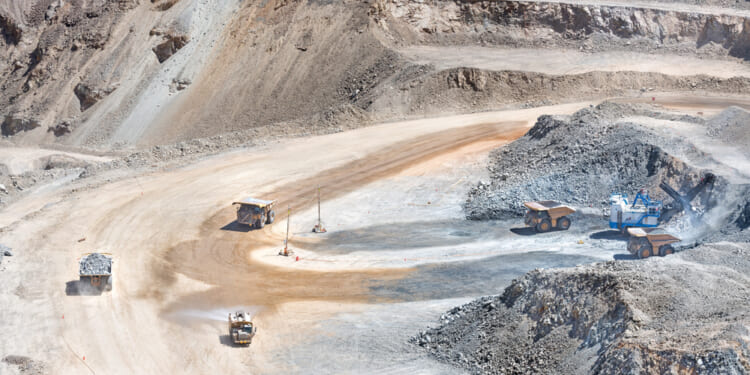Chinese clean energy dominance and AI-driven energy demand are reshaping global power dynamics, putting Latin America at the center of US–China competition for critical minerals.
Critical minerals, so-called because of their essential and irreplaceable role in modern manufacturing and defense supply chains, have emerged as a central geopolitical tension point between the United States and China. While China has spent years amassing a commanding critical mineral supply chain, the United States is seeking to quickly catch up. To that end, the mining industry and militaries around the world have taken notice of the Trump administration taking equity stakes in several critical mineral producers and exploration companies.
Most of these investments are in service of the US critical mineral supply and processing capacity, from rare earths to lithium and copper. While this is a positive development in US efforts to enhance the security and robustness of domestic critical mineral supplies, only one company that has enjoyed US government investment, the rare earth miner MP Materials, operates a producing asset. Lithium Americas, the Canadian-based company developing a large-scale lithium mine in Nevada, does not expect production to start until late 2027, with full production coming online in 2028.
Indeed, most US critical minerals projects are not expected to come online any time soon, leaving a major lacuna in US national security as these commodities are key to a wide range of commercial and military applications. Demand for everything from lithium and copper to rare earth minerals like dysprosium and terbium, essential to armaments manufacturing, is only going to increase over the next decade. With US minerals not reaching supply until years in the future, these minerals will have to come from partners abroad. Latin America, with significant mineral endowments and a history of extensive US involvement, will be at the forefront.
Latin America has long been a mineral resource powerhouse. Its gold and silver were key to the military might of the Spanish empire; its bauxite and chromium helped the Allied war effort in World War II; and its copper, nickel, and lithium are now central to geoeconomic competition between China and the United States. The critical minerals under Latin American soil form the backbone of batteries, electric grids, magnets, renewable power generation, and defense equipment, necessary for a new age of energy, technological, and military applications.
The rapidly increasing power demands of artificial intelligence (AI) loom large in the increased importance of critical minerals and what Latin America has to offer. AI, which is central to faster and more powerful computing, is the next big technological-industrial leap. AI has a voracious appetite for power, and is already straining power grids in frontrunners like China and the United States. Global data center electricity consumption has increased 12 percent per year since 2017 and is predicted by the International Energy Agency (IEA) to continue to expand up to 15 percent annually through 2030. By that date, AI-specific data centers will account for roughly three percent of global energy consumption, concentrated in just a few geographic hotspots, mostly in the United States and China.
China’s Head Start
China is the global leader in critical minerals and rare earths supply chains. China not only controls significant reserves of most critical minerals and rare earths but also dominates processing capacity that Western countries allowed to atrophy and were happy to outsource in an age of globalization. China is also quite willing to exercise its leverage in this space.
Today, China is responsible for most of the processing of lithium, copper, tungsten, and germanium, among others. Its biggest advantage, and where it has most weaponized mineral supplies, is in rare earths. China produces close to 70 percent of global production as of 2023 and over 85 percent of the world’s processing capacity for several materials. US production stands at 12 percent. This disparity has allowed China to use rare earth supply as leverage in the 2025 round of trade negotiations with the United States, where China imposed export restrictions on seven rare earths and magnets used in defense, energy, and automotive sectors. More recently, China announced broad export restrictions on rare earth elements, designed to further increase China’s processing and manufacturing power. In addition to its advantageous position in critical minerals, China holds a commanding position in solar and wind generation and equipment manufacturing, and is home to the highest number of electric vehicle sales globally. All of these entail massive amounts of domestically processed metals. In other words, China has increasingly ordered its economy and geoeconomics around critical mineral dominance.
Supported by state development banks and state-owned enterprises, as well as receiving active diplomatic support, Chinese companies expanded into mining projects across Latin America in the early 2000s. This often occurred in places where Western firms were more cautious, deterred by risky assets or were unwelcome, as in Bolivia, which nationalized its natural gas industry in 2006 and made entry into its lithium sector difficult.
China is now South America’s largest trading partner and a major investor, especially in extending assistance in the development of badly needed infrastructure. Some of this has come under the auspices of its multi-continental development program, the Belt and Road Initiative (BRI). This includes the giant Chancay Port in Peru, a $3.6 billion project meant to give China a major logistics hub on the Pacific coast of South America. It also facilitates the rapid transit of Peru’s critical minerals to China.
The United States’ Growing Engagement
Washington is playing catch-up with China. The Biden administration leaned heavily on industrial policy, using the Inflation Reduction Act and the CHIPS and Science Act to promote domestic processing and supply chain diversification. The second Trump administration has adopted a more direct approach, focusing on direct government investment in critical mineral companies, predicated on national security concerns, rather than the environmental and climate-related framing of the Biden administration. This has included the purchase of government stakes in MP Materials (rare earths), Lithium Americas, and Trilogy Metals (copper).
The Trump administration has also placed critical mineral supply at the center of its foreign policy, striking deals for expanded US capital investment in rare earths in Ukraine and critical minerals in the Democratic Republic of the Congo. Both of those deals were struck against a backdrop of peacekeeping deals, indicating that the United States is comfortable striking a peacemaking role in exchange for material benefit.
Latin America is a different matter. While several major US mining companies are actively engaged in Argentina, Brazil, and Chile, the business landscape has been complicated by the Trump administration’s penchant for tariffs, including on imported copper. Moreover, the Trump administration is aggressively scaling back foreign aid and soft power instruments, something at which China excels with its Confucius Institutes and aggressive messaging of propaganda, misinformation, and disinformation. Topping matters off, the Trump administration looks to reassert US hegemony in Latin America through an updated form of the Monroe Doctrine, which is politically complicated in the region at best, and vociferously rejected at worst. While the United States adopts a more transactional approach to foreign policy, China is attempting to harness disorientation and block back from the United States’ approach, and position itself as a longer-term partner without the baggage of historic Western colonialism.
Why Latin America Matters
Latin America looms large in the US-China rivalry, due to the region’s mineral richness, closeness to the United States, traditional north-south economic relations, and relative political stability. Moreover, mining has long been central to the region’s economies, leaving behind infrastructure, expertise, and regulatory systems that place Latin America at the center of the global minerals competition. Chile and Peru anchor global copper production, while Chile and Argentina account for 97 percent of US lithium imports, and Bolivia contains some of the world’s largest lithium deposits. Brazil has strategically valuable rare earths, including niobium, bauxite, nickel, and manganese.
For Latin American governments, this competition offers both opportunities and pressure. Most countries prefer not to choose sides between China and the United States. However, as a result of the United States’ transactional approach to foreign policy, and both countries viewing regional relationships as a zero-sum game, Latin American governments have been pressured to pick a side. For some Latin American countries, China is seen as a fairer partner, willing to invest in badly needed infrastructure that the West, for either political or market-based reasons, will not fund, as it has vowed non-intervention in local politics. While there are plenty of holes to poke in the Chinese marketing pitch, it has pitched itself as a more attractive partner than the Trump administration’s resuscitation of the Monroe Doctrine, the turning off of foreign assistance, and telling countries (with Brazil as the most acute example) how to run their domestic politics, and using tariffs as a weapon to cudgel them into submission.
Latin America has its own set of challenges and needs. Most countries do not wish to be a simple extractor of critical minerals but want to be part of the value-added process. They are not keen to have their resources solely in foreign hands, looking instead to build out processing and advanced manufacturing capacity to capture greater economic and geopolitical benefits from minerals under the ground. They also all contend with such environmental concerns as water rights, land stewardship, and Indigenous peoples’ rights that make project development increasingly challenging.
Shifting Political Landscapes
Latin America’s upcoming elections also have the potential to dramatically alter the region’s mining and energy landscape. This is certainly the case of Bolivia, where in August 2025, elections ended the 20-year rule of the Movement for Socialism (MAS), and two candidates, neither avowedly left-wing, are set to face off in the run-off election on October 19. Whoever wins will likely seek to open the lithium sector to foreign investors beyond the current handful of Chinese and Russian companies that were prioritized during the MAS government.
Probably one of the most significant elections is Chile’s presidential contest, in which a member of the communist party and a far-right lawmaker are the primary combatants. At stake is the nature of the Chilean state’s influence in the mining sector. Jeanette Jara, the leftist coalition’s candidate, favors increasing the role of state-owned Codelco, though she did walk back her earlier comments that implied she favored nationalization. The right-wing candidate, José Antonio Kast, on the other hand, favors a less statist approach, with a wider pathway for private investment and ownership of mining assets, which could possibly convert Chile’s mining system to be more in line with Argentina’s freewheeling mining regime.
In 2024, Argentina earned over $4.6 billion in mining exports, an increase of around 14.4 percent over the previous year, while mining is expected to top $5 billion in 2025. Argentina does not have a state-owned mining company. Instead, it leaves the mining screening process to provincial governments and is open for investment.
Critical Minerals in a New Geopolitical Era
Looking ahead, global demand for critical minerals will intensify. In this, Latin America is a strategic arena where China and the United States are grappling with securing supply chains. For Latin American governments, the challenge is to maximize gains while safeguarding sovereignty. For the major corporations engaged in mining in the region, success will hinge on anticipating volatility, managing governance and compliance risks, and cultivating durable local relationships.
Critical minerals are no longer peripheral to global affairs. They stand at the center of a new geopolitical contest—one in which Latin America is playing a decisive role.
About the Authors: Scott B. MacDonald and Brett Shearing
Dr. Scott MacDonald is the Chief Economist for Smith’s Research & Gradings and a Fellow with the Caribbean Policy Consortium. Prior to those positions, he worked for the Office of the Comptroller of the Currency, Credit Suisse, Donaldson, Lufkin and Jenrette, KWR International, and Mitsubishi Corporation. His most recent book is The New Cold War, China and the Caribbean (Palgrave Macmillan 2022).
Brett Shearing is an Associate Director at the Washington, DC office of The Risk Advisory Group, a global business intelligence firm that helps clients navigate above-ground risk, opportunity, and operating landscapes. Brett specializes in the mining, energy, and land use sectors. Prior to his career in corporate investigations, he spent several years working for a Canadian Member of Parliament, where he advised on energy and environmental policy.
Image: Jose Luis Stephens/shutterstock


















